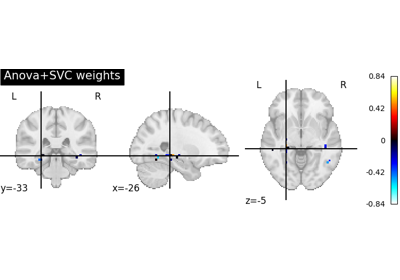Note
This page is a reference documentation. It only explains the function signature, and not how to use it. Please refer to the user guide for the big picture.
nilearn.plotting.plot_stat_map#
- nilearn.plotting.plot_stat_map(stat_map_img, bg_img=<MNI152Template>, cut_coords=None, output_file=None, display_mode='ortho', colorbar=True, cbar_tick_format='%.2g', figure=None, axes=None, title=None, threshold=1e-06, annotate=True, draw_cross=True, black_bg='auto', cmap=<matplotlib.colors.LinearSegmentedColormap object>, symmetric_cbar='auto', dim='auto', vmax=None, resampling_interpolation='continuous', **kwargs)[source]#
Plot cuts of an ROI/mask image (by default 3 cuts: Frontal, Axial, and Lateral)
- Parameters
- stat_map_imgNiimg-like object
See http://nilearn.github.io/manipulating_images/input_output.html The statistical map image
- bg_imgNiimg-like object, optional
See input_output. The background image to plot on top of. If nothing is specified, the MNI152 template will be used. To turn off background image, just pass “bg_img=None”. Default=MNI152TEMPLATE.
- cut_coordsNone, a
tupleoffloat, orint, optional The MNI coordinates of the point where the cut is performed.
If
display_modeis ‘ortho’ or ‘tiled’, this should be a 3-tuple:(x, y, z)For
display_mode == 'x', ‘y’, or ‘z’, then these are the coordinates of each cut in the corresponding direction.If
Noneis given, the cuts are calculated automatically.If
display_modeis ‘mosaic’, and the number of cuts is the same for all directions,cut_coordscan be specified as an integer. It can also be a length 3 tuple specifying the number of cuts for every direction if these are different.
Note
If
display_modeis ‘x’, ‘y’ or ‘z’,cut_coordscan be an integer, in which case it specifies the number of cuts to perform.- output_file
str, or None, optional The name of an image file to export the plot to. Valid extensions are .png, .pdf, .svg. If
output_fileis not None, the plot is saved to a file, and the display is closed.- display_mode{‘ortho’, ‘tiled’, ‘mosaic’,’x’,’y’, ‘z’, ‘yx’, ‘xz’, ‘yz’}, optional
Choose the direction of the cuts:
‘x’: sagital
‘y’: coronal
‘z’: axial
‘ortho’: three cuts are performed in orthogonal directions
‘tiled’: three cuts are performed and arranged in a 2x2 grid
‘mosaic’: three cuts are performed along multiple rows and columns
Default=’ortho’.
- colorbar
bool, optional If
True, display a colorbar on the right of the plots. Default=True.- cbar_tick_format: str, optional
Controls how to format the tick labels of the colorbar. Ex: use “%i” to display as integers. Default is ‘%.2g’ for scientific notation.
- figure
int, ormatplotlib.figure.Figure, or None, optional Matplotlib figure used or its number. If
Noneis given, a new figure is created.- axes
matplotlib.axes.Axes, or 4 tupleoffloat: (xmin, ymin, width, height), optional The axes, or the coordinates, in matplotlib figure space, of the axes used to display the plot. If
None, the complete figure is used.- title
str, or None, optional The title displayed on the figure. Default=None.
- thresholda number, None, or ‘auto’, optional
If
Noneis given, the image is not thresholded. If a number is given, it is used to threshold the image: values below the threshold (in absolute value) are plotted as transparent. If ‘auto’ is given, the threshold is determined magically by analysis of the image. Default=1e-6.- annotate
bool, optional If
annotateisTrue, positions and left/right annotation are added to the plot. Default=True.- draw_cross
bool, optional If
draw_crossisTrue, a cross is drawn on the plot to indicate the cut position. Default=True.- black_bg
bool, or ‘auto’, optional If
True, the background of the image is set to be black. If you wish to save figures with a black background, you will need to pass facecolor=’k’, edgecolor=’k’ tomatplotlib.pyplot.savefig. Default=’auto’.- cmap
matplotlib.colors.Colormap, orstr, optional The colormap to use. Either a string which is a name of a matplotlib colormap, or a matplotlib colormap object.
Note
The colormap must be symmetrical.
Default=`plt.cm.cold_hot`.
- symmetric_cbar
bool, or ‘auto’, optional Specifies whether the colorbar should range from
-vmaxtovmaxor fromvmintovmax. Setting to ‘auto’ will select the latter if the range of the whole image is either positive or negative.Note
The colormap will always range from
-vmaxtovmax.Default=’auto’.
- dim
float, or ‘auto’, optional Dimming factor applied to background image. By default, automatic heuristics are applied based upon the background image intensity. Accepted float values, where a typical span is between -2 and 2 (-2 = increase contrast; 2 = decrease contrast), but larger values can be used for a more pronounced effect. 0 means no dimming. Default=’auto’.
- vmax
float, optional Upper bound of the colormap. If
None, the max of the image is used. Passed tomatplotlib.pyplot.imshow.- resampling_interpolation
str, optional Interpolation to use when resampling the image to the destination space. Can be:
“continuous”: use 3rd-order spline interpolation
“nearest”: use nearest-neighbor mapping.
Note
“nearest” is faster but can be noisier in some cases.
Default=’continuous’.
See also
nilearn.plotting.plot_anatTo simply plot anatomical images
nilearn.plotting.plot_epiTo simply plot raw EPI images
nilearn.plotting.plot_glass_brainTo plot maps in a glass brain
Notes
Arrays should be passed in numpy convention: (x, y, z) ordered.
For visualization, non-finite values found in passed ‘stat_map_img’ or ‘bg_img’ are set to zero.
